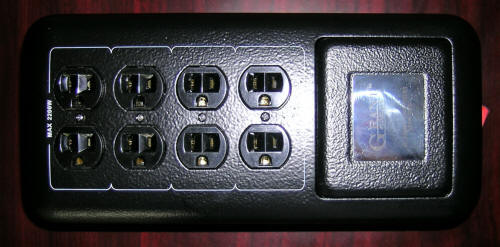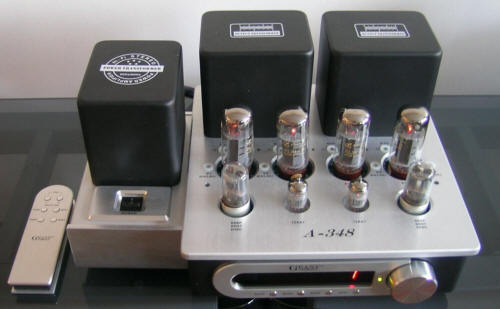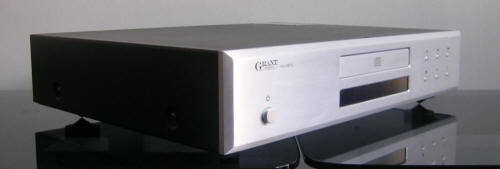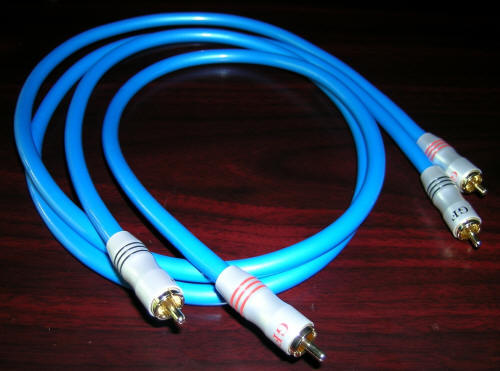You are reading the older HTML site
Positive Feedback ISSUE
september/october 2008
Grant Fidelity - A Systems Approach
by Mike Peshkin
Just as thunderstorm weather is reaching its height and I'm growing more and more paranoid about one of my systems connected up to (horrors) a MOV type power filter, in comes Grant Fidelity's MPF-120. It is a simply laid out design with 8 outlets provided; a maximum load of 2200 watts; my type of chassis for this type of device, a black box. Black boxes are boring, but power conditioners are supposed to do all of their work in the background. I don't need them to be flashy and pull my eyes away from my pretty tube pre-amp!
The MPF-120 does what any good power conditioner should do—filter out the dirt. But I want it to do something else, in the area where I live it MUST protect the equipment from surges. My neighborhood has at least one or two power interruptions every single month! One reason is electric lines that delivered power to about 10 farms now delivers power to a few hundred (thousand?) homes. The reason isn't important, I've griped to the powers that be and they merely shrug their collective shoulders. The micro-blackout scares the heck out of me, but when one occurred while listening to music with the Grant Fidelity in the line I didn't even know it had happened. "Did you know the power went out again," asked my wife. "Nope, didn't hear a thing." This is NOT a power supply, it does not generate any electricity; but the micro black-out and subsequent surge did not interrupt my enjoyment listening to music. The black box does its job!
I'm not listening to my big system downstairs; I have set up shop for an impending operation. After my left knee is replaced next month, I won't be able to venture to my sanctum sanctorum, my dungeon for at least a few weeks. That's long enough to drive a music lover nuts! Thus I've taken the first steps to have a system upstairs worthy of great music. The little Dared integrated is a fine little amp, but it ain't the amp the Mapleshade modded Scott 222C is. So for right now, the integrated amp from Grant Audio, a Canadian company (have you ever heard anything but great stuff from Canada…it must be the cold weather!). It's two amps in one, a quick re-biasing of the tubes and you change from KT88s to EL34s, from an audiophile/music lover's amp to a music lover/audiophile's amp! Those are Ian Grant's words, not mine. I don't agree, at least under most circumstances. I'm willing to concede he's correct, but I liked the KT88's while listening to CDs through the equally fine Grant Fidelity CDP.
A-348 integrated amp
-
Output Power: 50W RMS/channel minimum
-
Output Impedance: 4 ohm and 8 ohm
-
Frequency Response: 6Hz - 70 KHz (-2dB)
-
Distortion: less than 1.6% @ 40 W
-
Input Impedance: 20Kohm
-
Input Sensitivity: 250mV
-
S/N Ratio: >88dBa
-
Vacuum Tubes: EL34B×4, 6N8Px2, 12AX7x2
The amp comes with EL34s, with that bias change you have a KT88 amp! Which is a good thing since he sent two sets of tubes. I was able to listen to the amp when I broke one of the EL34s! What a klutz…I guess I shouldn't be too hard on myself that's the first time I ever broke a tube. To soothe my savage breast, Ian told me it was no big deal, he'd send another quad set of EL34s. Since the tubes were new, I could have gotten away with a single replacement tube.
This package is fun! Along with the CDP they sent me, I am not missing my vinyl collection. This may be the very first time that's happened. Maybe it's the mind-set, knowing that CDs are going to be much easier to load than placing a record on a turntable. I wouldn't want to lose my balance and land on my derrière, however cushioned it is (not! As large as I am, I'm a flat-butt!).
Watching those big KT88s glow is like sitting in front of a fireplace…except no flickering. Wouldn't it be cool if they could make them flicker and operate within their specifications? But then, Jordi Savall's viola is perfect accompaniment to the fireplace idea. AliaVox AV9827 Mr. de Sainte Colombe Le Fils, pieces de viole is a CD of worthy mention. I just can't get enough of this double CD. I play it at least every couple of weeks, far more, I think, than any CD I own. The string sound on this CD is the equal of any LP, and I've always thought that was one of the strongest points of LP playback.
Savall's viola resonates throughout the living room, a startlingly life-like sound. The Grant amp doesn't even breathe hard as it reaches into the depths that Savall's viola travels through. I am using a pair of Role Audio speakers that are not especially efficient, but quite easy to drive. They "do" bass about as good as any speaker I've listened to, perhaps better…maybe because of that wonderful Grant amp?
I had an interesting experience with, Boz Scaggs' Come on Home when, after listening to CD after CD (Did I say I am enjoying this amp immensely?). With the KT88's everything, I mean everything sounded wonderful, except Come on Home. I may have had the sampling rate set incorrectly, but Scaggs' voice was a bit hard. Later, when the replacement arrived for the EL34 tubes in the circuitry, I hear Boz's bluesy voice just fine! I'm listening to the CD as I write this, the Role speakers filling this room with great sound…which is good, because it's great music! I suppose what I'm saying is that it's a difficult decision as to which tubes you feel will sound the best with this amp. I played with different settings as the CDP's sampling rate can be changed quite easily, if a fumble fingered guy like me can do it (and understand how to) then anyone can.
Ian Grant, commenting on power cords and the rest of the ensemble:
I'm a recording engineer (and did mechanical engineering to pay for it). It was once explained to me that you need to look at it from the perspective of the unit looking out into the power grid to make the cleanest connection. Kind of the opposite of plumbing, as most think of electricity.
Push stop to clear the DAC (must) then push the 'display' button' to cycle through the sampling rates. 44.1k is off, 88.2k is for when you can't decide and 176.4k is the default and works best with well recorded and post 1992 CD's. 44.1k is usually much more musical and natural sounding with pre-1992 CDs where the tubes put the harsh mastering back into the soundstage.
You will also notice an extra set of KT-88 tubes. The A-348 comes stock with EL-34s and can be upgraded to KT-88's. I like to suggest to audio nuts that the EL-34 is for music lovers and the KT-88 is for audiophiles or system lovers. Of course that is a wide generalization as they both do each other great.
The A-348 easily allows for one to have basically 2 amps in one. The amp was biased before I sent it to you at probably about .38v, you can set between .35 and .4 with the higher end giving slightly better bass control and the lower end giving slightly more 'old school' tube sound. For the KT-88's the range is between .48 and .6, I personally like .48 with the KT88's. Please bias right after switching tubes and check after an hour of warm-up. All the tubes and components have enough time on them for serious listening. The A-348 is ready to go after pre-heat, but for serious listening, at least 10 minutes warm-up is recommended. Ditto the CDP.
A very cool feature of the CD-327A is the adjustable and defeatable oversampling, which you can select from the remote (the display button cycles through 44.1k, 88.2 and 176.4. You need to stop the music to flush the 192k/24 bit custom programmed DAC, prior to switching, it defaults to 176k. With basically every pre '92 and a lot after CDs being re-mastered from vinyl masters they can sound terrible on oversampling CDP's. The CD-327A does a great job of making an old CD listenable by defeating the upsampling (44.1k) and letting the tubes soften up the top and by placing it in the soundstage. I can ramble on about this :)
Ian
I thought I'd have a problem biasing the tubes, as I had never owned a piece of equipment needing bias adjustment. You will have to purchase a voltmeter, and Ian has supplied a tool to do the biasing safely and easily. Again, if I can do it, anyone can.
Those who don't believe wires make a difference please, as Ian Grant says, begin thinking of power cords as the beginning of a connection to the electricity coming into your home, not the end. Part of the entire package, the cords did make a difference between slightly thin sound and robust reproduction. I heard a string break in one passage of Tone Poems. I've never heard it before. I played the same part with the stock cord and no power conditioner. The sound was softened enough without the conditioning I realized I'd have probably missed it. It was toward the end of my time with this gear and I wanted to find out what the absence of the power conditioner would do or not do to the sound. I was playing Dave Grisman's Tone Poems II and plugged the map directly into the wall. There had been a shimmer, a gorgeous decay from every plucked string. It was gone! Well, barely there, I doubt that I would have noticed it before had I used the amp without the conditioner. I put a stock cord into the wall, for about .0003 seconds. I turned the amp off, replaced the Grant Fidelity power cord, plugged it into the power conditioner and listened to "It had to be You" a second time. The music sounded louder, as if I'd turned up the volume. Martin Taylor's guitar leapt out of the speaker where moments before it had sounded recessed.
Time and time again I found myself muttering, "How can this sound as good and cost so little?" This is one of those monster bang for the buck things that comes around far too rarely in audio. Virtually everyone who came into my home, almost none of them music listeners and surely not audio buffs, commented on how good the sound was. Looking at my notes, the word gutsy shows up over and over again. Yes, 50 tube watts should sound pretty gutsy, but it's more than just that. This is not just another pretty tube amp, it possesses the capability to have you enjoy your music, your way.
I began playing CDs I hadn't played in a number of years, some I'd listened to only once because they didn't grab me. Every CD I played grabbed me. It didn't matter whether it was the really early Blue Note CD reissues or those RVG remasters, I spent hours more than I should have listening to music. My wife wanted to watch The Closer and although I like the show too, I wanted to listen to more music.
Was it the Role speakers, the CDP, the amp, the wires, or the combination of all of them? I don't know, but I wanted to listen, listen, listen. I did find out that in this room, with the speakers available, I did not agree with Ian Grant about the tubes. I liked the KT-88 sound better. I thought it was far more musical, far more engaging.
If I had not heard the KT-88s first, perhaps my findings (feeling?) would be different. The sound of the EL34s is engaging and musical, the sound with the KT-88s was lush, musical, and engaging. Maybe I'm as crazy as a blind arachnid, but that is what I heard. None the less, I'd like both amplifiers in my home, I'll regret sending these back to Papa.
This is a package, folks. This wonderful sound comes at you grouped together, or as single entities. Buy an amp, buy a CD player, buy a power conditioner and wires? Or, just get the whole package. And as I've written, it is some kinda package!
A-348 tube amp - $1329
CD-327A - $949
RCA-1 $99
SPC-2.5 speaker cable - $129
PC-1.5 x 2, $149 each
RPF-120, $379
Total: MSRP $3183 - system MSRP at 10% off $2865 USD.
This is, and if I offend anyone with this comment, I DON'T apologize, chump change. You could spend a fortune on a pair of speakers, this package would make any choice within reason valid, and still be happy with this gear for a long, long time. When you've owned it for a long time and find yourself getting bored, have upgrade fever? Just change tubes; voila, a new amp!
I wanted to find out something about the power conditioner, as I am in the market for one to protect the game room system (that is right in front of me as I write this, acting as my recuperative system).
I disconnected the gear, plugged it into the wall and listened. As I touched upon earlier, I didn't leave the power conditioner out of the total equation for very long at all. One thing people worry about is limited dynamics when using a power conditioner. I'm trying not to harp, but every bang and ba-rroom that the CDP delivered and the integrated amp passed on to the speakers is there in spades. I had forgotten and was truly shocked at how much information is lost when a good power conditioner is taken out of the loop. I've been a believer in power conditioning for a long, long time.
Back when the best ones cost a fortune and still had metal oxide varistors, I used an inexpensive Adcom ACE. I upgraded to the quite good Monster power strips and found they were quieter, better parts make better conditioners just as better parts make better anything! But they had MOVs, too.
I've had an MOV based power conditioner fail, another friend has had one fail and then I decided I wouldn't use anything employing MOVs ever again. I purchased the very good Brickwall filters and that is the standard I expected from a power conditioner. No compression or limited current, protection against the many, many surges we get around here, and silence! That is a hugely important requirement. The Grant Fidelity does what is expected and even surprised me the other day when we had one of our far too often micro-blackouts.
That's the reason my MOV filters failed and that's the reason I bought Brickwalls. I expected the same performance from the Grant. The stove clock needed reset, the microwave needed reset, but while listening to music there was no flicker, no pop, no interruption…and THAT is what I want from a power conditioner! It is not a power supply; decent power supplies are hugely expensive, yet that less than one second blackout did nothing to scare me…and I do get frightened for my equipment's health. The Brickwalls are great policemen, the Grant Fidelity is a great policeman, too.
The package comes with some great IC's, power cords, and speaker wires. I did not have a chance to compare the many wires at my disposal as I rely on friends to change out equipment. The wires are gorgeously made and I suspect one would have little reason to play the wire of the week game.
I enjoyed playing with the CDP and its upsampling features. I did find, as Ian Grant had told me, that some CDs that sounded a bit harsh were far smoother sampled at different rates. The HDCD discs surprised me, I expected Tone Poems to sound its best at the highest sampling rate. It sounded wonderful at 88.1.
As I packed up the equipment I was amazed once again, at the quality of everything I'd been listening to for the past month. Big things, little things, everything was built to the highest standards. Even the tube cage fits firmly and beautifully on top of the unit and is easily lifted and removed. The amp is actually two in two chassis, the power supply in the smaller of the two cases, amplification in the larger. Rugged looking and rugged acting; I never had the feeling during my time with this gear, that it would give me any sort of problem…rock solid. The remote of the CDP and the remote of the amp were both hefty little buggers. The amp's remote changes input and controls volume; a beautiful feature when switching from CD to TV sound when I wanted to listen to the satellite music stations. The CD player's remote controls the play sequence and sampling rate.
I would love to tell you that I had the parts of this system connected with other gear, but I didn't because I thought the package as is to be all anyone would ever want, I am NOT kidding. Great sound and great looks at a great price. The only thing I'd add is an outboard phono stage and I could be happy with this system until the day I leave this planet to go to some other part of space. If one adds a good set of speakers like the Role Audio Windjammers that I had in house under review for another on-line mag, they would and could be happy for the rest of their lives. I know I was. Every morning I'd turn the system on and listen while I ate breakfast, marveling at the sound that filled my great room. 50' x 25' is a lot of space to fill with powerful sound, yet that combo did it and did it very, very well.
I really have nothing more to say, I could have just put a smiley face on the computer and that would have told you all you needed to know.
Ian Grant requested that I review the gear as a complete system. I wanted to but didn't have the time before my knee replacement, to try all of the gear, one by one, in my basement system. Remember, oh mighty reader, nothing of that which I'm reporting could have happened with the entire chain having a weak link. Any shortcomings of any of the gear would have told me something to report…I'm sorry for those who like to read about negatives …there ain't any.
The cutting edge? You are not going to hear gut cringing attack, gut wrenching decay, nor gut quivering midrange power from gear like this. Sorry. You'd have to spend thousands more to improve upon what my listener friends and I heard. Again and again they or I uttered, "This fabulous for 6 grand?" The amount I thought for this gear was incorrect.
The ICs, the power cords, and the speaker wires are top-notch items, if you only wish to try different wires, they are definitely worth the postage to get a listen. The CD player delivered the sounds I've written of above. The Amp is gorgeous, a work of electronic art. A bit frightening to have to do the biasing of the tubes, but with the supplied tool it just ain't no big thing.
Both the amp's remote and the CDP's remote are well laid out, no hundred never used buttons on them, not even a power switch! Both feel like they were cut from a ten ton brick of aluminum…don't drop either of them on your toe. I'm not kidding and I'm not going to kick the dog for brushing it off the table and onto my toe with her tail.
At the MSRP it's a no brainer. At the package price? You would have to be one of those guys who has to pay top dollar in Georgetown for a pair of shoes you could have gotten in this ‘burg for $100 less so you could say, "I bought these shoes in Georgetown for $400."
Buy the system, and when your buddy who deals in wine futures asks what you paid you can tell him, "It was only $11,000." Even if he knows something about listening, he'll believe you.
web address: http://grantfidelity.com




